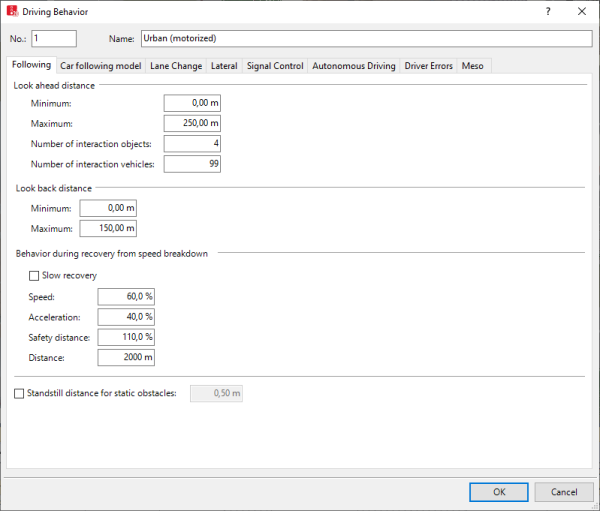Editing the driving behavior parameter Following behavior
1. From the Base Data menu, choose Driving Behaviors.
The Driving Behaviors list opens. Some driving behavior parameter sets can be predefined.
By default, you can edit the list (Using lists).
You can edit all driving behavior parameters for lane change, lateral behavior and following behavior in the list or in tabs with the following steps.

|
Note: In lists, you can use the |
2. Right-click the entry of your choice.
3. From the shortcut menu, choose Edit.
The Driving Behavior window opens.
4. Select the Following tab.

5. Enter the desired data.
| Element | Description |
|---|---|
|
Look ahead distance |
Minimum, Maximum: Minimum and maximum distance that a vehicle can see forward in order to react to other vehicles and interaction objects that are in front of or next to it on the same link. Vehicles take into account the minimum and maximum look-ahead distance in addition to the entered number of interaction objects. Even when driving up to a stationary obstacle, vehicles reduce their speed evenly on the basis of the look ahead distance. The Minimum look-ahead distance is important when modeling the lateral behavior of vehicles.
Only the Maximum look-ahead distance needs to be extended, e.g. to model rail traffic with block signals (Modeling railroad block signals). |
|
Number of interaction objects |
Number of preceding vehicles and/or number of network objects listed below which the vehicle perceives downstream or adjacent to it on the same link in order to react to them. In addition to the number of observed vehicles entered, vehicles take the minimum and maximum Look ahead distance into account. In Vissim, the following network objects are modeled as vehicles. Vehicles treat these network objects as a preceding vehicle. These network objects act like a red signal head. If there are several of these network objects within a very short distance, enter a larger number for the Number of interaction objects. However, this can lead to slightly longer simulation computation times.
Vehicles also treat the following network objects as a preceding vehicle, when they have to stop there:
Behavior in conflict areas: A vehicle takes into consideration all downstream conflict areas, up to the furthest interaction object specified under the number of interaction objects. Default values of Number of interaction objects for predefined driving behavior:
In the attribute Number of interaction vehicles, under Number of interaction objects, you can specify the number of vehicles that Vissim takes into account in addition to the above-mentioned network objects. The vehicle is maximally aware of the Number of interaction objects. |
|
Number of interaction vehicles |
Number of preceding vehicles which the vehicle perceives downstream or adjacent to it on the same link in order to react to them.
Default value for all predefined driving behaviors: 99 vehicles. For example, if you are modeling an autonomous vehicle whose sensors are blocked through a preceding vehicle which is preventing it from detecting other vehicles, set the Number of interaction vehicles to 1. |
|
Look back distance |
Minimum, Maximum: The Look back distance defines the minimum and maximum distance that a vehicle can see backwards in order to react to other vehicles behind it (on the same link). The minimum look-back distance is important when modeling lateral vehicle behavior. If several vehicles can overtake within a lane, this value needs to be greater than 0.00, e.g. in urban areas it could be 20-30m, with correspondingly larger values in other places. This way you make sure the cars drive in an orderly fashion, when on the same route two or more vehicles than specified in the attribute Number of interaction objects want to position themselves at a stop line. This applies in particular to bicycles. You can reduce the maximum look-back distance in close-meshed networks, e.g. with many connectors over a short distance. This may positively affect the simulation speed. |
|
Standstill distance for static obstacles |
Standstill distance (ax) upstream of static obstacles. These are, for example, signal heads, stop signs, bus stops, priority rules, conflict areas. Not valid for stop signs in parking lots. The attribute Smooth closeup behavior must be selected.
|
In the Driving behavior list, you can select additional attributes. Among them are the following for example:
| Element | Description |
|---|---|
|
Increased Acceleration |
IncrsAccel: Allows you to increase the acceleration with which the vehicle follows a preceding vehicle that accelerates. Default value 100 %, value range 100 % to 999 %. With the default value 100%, the vehicle falls back in distance from the preceding vehicle when the latter accelerates. Only when the preceding vehicle stops accelerating does the following vehicle approach it. If the value > 100 %, the vehicle accelerates when the preceding vehicle accelerates and unimpeded acceleration is possible. Increased Acceleration affects the car following models Wiedemann 74 and Wiedemann 99. Increased Acceleration has an impact on the following types of acceleration:
Jerk limitation in the Wiedemann 99 car following model: If the vehicle is in the interaction state Free, acceleration is limited in the first time step of the vehicle via the model parameter CC7 Oscillation Acceleration. Jerk limitation is not performed if a value > 100 % is selected for Increased Acceleration, the distance dx > safety distance dsx and the preceding vehicle is accelerating. |

 If this option is not selected, the vehicles use a normally distributed random value [0.5; 0.15].
If this option is not selected, the vehicles use a normally distributed random value [0.5; 0.15]. If the option is selected, vehicles use the entered value, minimum: 0.01 m. The default value is 0.5 m. If you open an
If the option is selected, vehicles use the entered value, minimum: 0.01 m. The default value is 0.5 m. If you open an 